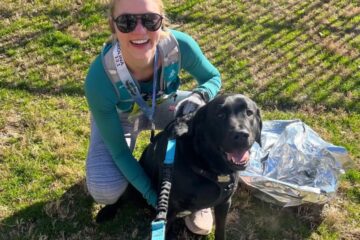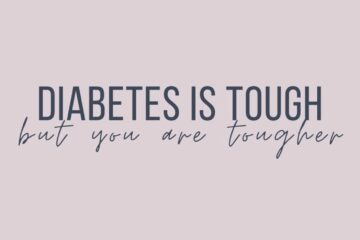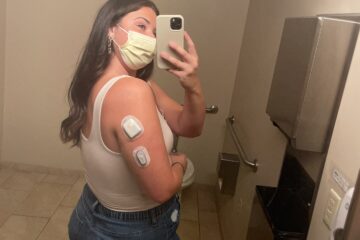Managing Type 1 Diabetes is a journey filled with unique challenges, and no two people experience it the same way. From the quirks of how different foods impact blood sugar to the unexpected perks of life with diabetes, every individual’s experience is personal.
In this interview, I got to chat with Addy Tayler, a T1D influencer and advocate, to chat about the highs, lows, and everything in between. From balancing diabetes and motherhood to the first thing she’d do if a cure were found, this Q&A offers a candid and insightful look at life with Type 1 Diabetes.
Addy: Hey! How’s it going?
Ashlyn: I’m doing great, how about you?
Addy: I’m great! So, this is for a college project, right?
Ashlyn: Yeah! I’m in a Social Media Marketing class at Belmont University in Nashville. Our semester-long project is to create a full blog and social media campaign, post on it throughout the semester, and track engagement. The professor encouraged us to pick a topic we’re passionate about, so I immediately thought of this—something I know well and can create a lot of content around. It’s been an intense but fun experience, pushing me outside of my comfort zone in a good way.
Addy: That sounds like a great project! How long have you had Type 1?
Ashlyn: I just hit my three-year mark at the end of January! It doesn’t feel like that long, but my mom has had Type 1 my whole life, so I was already really familiar with everything. The transition was still an adjustment, but probably easier for me than it is for most.
Addy: That makes sense—it’s great that you had that background going into it.
Ashlyn: Exactly! That’s why this project has felt so natural. It’s easy to create content when it’s personal, and I feel like I can really connect with people. I also wanted to reach out to others who are active on social media, raising awareness and sharing their experiences. I’m really interested in how people decide to use social media for advocacy—whether it’s helped them, what challenges they’ve faced, and how they’ve built a community. You seem to be doing really well with it, so I’d love to hear about your experience!
Addy: I was diagnosed with Type 1 diabetes in November 2022—just over two years ago—shortly after my 24th birthday. Leading up to my diagnosis, I had been experiencing extreme thirst and frequent urination for months. It got to the point where my husband was frustrated, telling me, “You cannot be this thirsty all the time!” But I was. I carried two water bottles everywhere—one for the car and one for wherever we were going.
That Thanksgiving, we took a 14-hour road trip to visit my in-laws in Idaho. I remember being oddly proud that I could go two hours without needing a bathroom break, but deep down, I knew something wasn’t right. A few months earlier, I had even told my sister, “I think I have diabetes.” She brushed it off, and so did I.
When we finally arrived in Idaho late at night, I insisted on stopping at Walgreens to buy a blood sugar test kit. My husband asked, “Are you serious?” But I was determined. As I checked out, the Walgreens cashier casually said, “Good luck.” I didn’t think much of it at the time, but looking back, it felt like an eerie sign of what was coming.
At my in-laws’ house, my mother-in-law—who has been a nurse her whole life—helped me check my blood sugar. The result? Somewhere in the high 400s. Her immediate reaction was, “Oh my hell.” Now, this is a woman who never swears, so when she said that, I knew it was bad.
Still in denial, I washed my hands and tested again. Same number. We tested everyone else in the house for comparison—all between 70 and 90. My mother-in-law urged me to go to the ER, but I felt fine and had no idea how my insurance worked in Idaho. Instead, I decided to wait and see a doctor after the holiday.
The following Monday, I visited a family nurse practitioner, who checked my A1C and blood sugar. They quickly diagnosed me with Type 2 diabetes and put me on Mounjaro, a medication for Type 2. I didn’t know much about diabetes, but I knew enough to be confused. My grandmother had Type 2, but this just didn’t feel right.
I started taking Mounjaro that same day, but no matter what I did, my blood sugar stayed in the 500s. I was terrified. Out of desperation, I practically stopped eating. On Thanksgiving Day, the only thing I ate was plain turkey.
A week later, back home, I scheduled an appointment with an endocrinologist. By that point, I had lost 10 pounds from barely eating. After running more tests, the doctor gave me the real diagnosis: Type 1 diabetes.
I was told to stop taking Mounjaro immediately—it wasn’t helping me. Instead, I was prescribed insulin and a continuous glucose monitor (CGM). While the adjustment wasn’t easy, I finally had the right treatment.
Now, here I am—navigating life with Type 1 diabetes, learning every day, and sharing my journey so others don’t feel as lost as I did.
Ashlyn: Everyone’s diagnosis story is unique, but I feel like there are often common themes. You discussed mentioning to yur sister that you might have diabetes. Before I was diagnosed, I had a friend whose boyfriend had Type 1 diabetes. A few months before my diagnosis, we were at a football game, and I was drinking water nonstop. She casually said, “You might have diabetes.” I laughed it off, thinking, “No way.” Looking back, the signs were all there—my hair was thinning, my face looked different, and I just didn’t feel right. But at the time, I thought, “Well, I’m losing weight, so I must be fine.” Spoiler: I was not fine.
Addy: This experience connects to a larger issue—the lack of proper diabetes education, both in healthcare and general awareness.
I firmly believe that diabetes is not taught well, even in medical school unless you are studying to be an endocrinologist. I don’t know exactly how much time is dedicated to it, but I imagine it’s minimal—probably just a few days covering “Type 1 and Type 2 exist and here are the differences,” and that’s it. If I could change anything, it would be ensuring all doctors receive proper training on distinguishing between Type 1 and Type 2. The tests are straightforward, yet so many people—especially adults—are misdiagnosed.
Ashlyn: I remember learning about diabetes in health class before I was diagnosed, but even then, key details were missing. I already knew a lot because my mom has Type 1, but I recall thinking, “Shouldn’t they be covering this part?” Of course, I wasn’t about to correct the teacher, but I knew some topics were not being explored as much as they should be.
Even today, many of my friends still make misinformed comments. I often have to correct them, saying, “That’s not true. Please don’t believe that.” There’s just so much misinformation out there.
Addy: This is why better education—both in healthcare and general public awareness—is so important. No one should go through a misdiagnosis like I did. When I was finally diagnosed, there was zero doubt I had Type 1. But for many adults, the default assumption is “Oh, they’re older, so it must be Type 2.” This mindset needs to change.
Ashlyn: Do you think social media and T1D influencers have helped improve diabetes education?
Addy: This question actually made me laugh because the first thing I did after being diagnosed was sit on the floor of my in-law’s basement and search “diabetes” on TikTok. I was desperate to learn anything I could, and I remember thinking, what the heck? I just wish more people understood that Type 1 Diabetes isn’t caused by diet or lifestyle. It’s frustrating when people assume otherwise—it’s discouraging to hear comments like, “Wow, you have diabetes? But you’re so young and healthy!”
Ashlyn: I’ve had the same experience. People would ask if I had Type 1 or Type 2, and when I said Type 1, they’d respond with, “Yeah, I thought you were too healthy to have Type 2.” That kind of thinking shows how much education is still needed. Type 1 is autoimmune and largely hereditary, while Type 2 can be a different story.
Addy: Exactly! When I first started learning about diabetes, I remember seeing someone post about going on a walk to lower a high blood sugar. I had no idea if she took insulin first or just went for a walk—it was all so confusing. Now, I always try to be really clear in my own content because I know how much those little details matter to someone newly diagnosed. Back then, I didn’t understand anything, and that was the hardest part. I’ve always been someone who works hard and strives to do my best, but no matter what I did, my blood sugar would spike to 300 and then crash to 50. I felt like I had no control.
That’s when I turned to Facebook. I know it’s not as popular these days, but I found a Type 1 support group, and I spent hours reading posts, trying to soak up every bit of information I could. There are so many great resources now—books, podcasts like The Juicebox Podcast, and more—but for me, social media was the first place I turned.
Ashlyn: That’s really interesting. So, is that what inspired you to start posting about T1D yourself?
Addy: Yeah! In January 2024, I posted for the first time. At first, it was more of a journal for myself than anything else. I don’t consider myself super creative or artsy, but I enjoyed following trends and making content. I started posting one or two videos a day, and I’ve kept that up ever since.
At first, my account grew really slowly, which didn’t bother me because my goal wasn’t to get a huge following—I just wanted to help people. It wasn’t until December that I hit 10,000 followers, and then in the last month or two, my account has grown so much. The messages I get now make me emotional—people tell me they’ve learned more from my videos than from their doctors. That’s exactly what I needed when I was diagnosed, so to be that person for someone else feels surreal.
Ashlyn: That’s incredible. It really shows how powerful social media can be for education and support. I think some people worry that medical content on social media is oversaturated, but I don’t think it ever can be—especially for chronic illnesses. Everyone experiences diabetes differently, and someone might resonate with your approach in a way they wouldn’t with someone else’s. The more perspectives we have, the better. I think that’s why medical content tends to perform well—it’s so relatable, and it meets people where they are.
I also have to applaud your consistency—posting that often is a lot of work! And you’re a mom too, right?
Addy: Yes, I am.
Ashlyn: That must be exhausting! How has that been in terms of balancing diabetes burnout with your lifestyle? Not just as a mom, but in general, since managing T1D can be overwhelming.
Addy: Yeah, it can be crazy. I actually joined a Facebook group for support—that’s where I got so much of my information early on. Fortunately, I had a very straightforward and healthy pregnancy. Some people experience extreme insulin resistance, where they need a 1:1 insulin-to-carb ratio, and I was terrified of that. Type 1 itself isn’t the villain, but when you have to take 15 units of insulin for a salad, that’s a little scary.
Ashlyn: And then you run out of insulin quickly and have to pay for more—definitely not ideal.
Addy: Exactly! I was so grateful that I didn’t experience that extreme resistance. But after having my son, my priorities shifted in a way I wasn’t expecting. Before, my blood sugar was my top priority—if it was high, I’d immediately go for a walk up and down the stairs for 20 minutes. Now, if my blood sugar is high but my baby is crying, hungry, or needs a diaper change, he comes first. That shift was tough, and honestly, it still is sometimes.
But in a way, it’s been good for me. It’s forced me to find balance and not stress over every little fluctuation. Managing diabetes is all about making it work for your lifestyle—there’s no one-size-fits-all approach. You just have to find what works for you and roll with it.
Ashlyn: Are you ready for a little rapid fire segment?
Addy: Let’s do it!
Ashlyn: What’s your diabetes quirk—something unusual about how your blood sugar reacts? Like a food that doesn’t require insulin but another that sends you sky-high?
Addy: My stairs, for sure. They’re my best friend. If I eat a really carb-heavy dinner, I’ll just walk up and down the stairs for 15 to 20 minutes—it’s such a life hack! High blood sugar? Go for a walk. Works every time.
As for food, popcorn is weird for me. If I eat it during the day, my blood sugar skyrockets. But if I eat it after dinner, I can have a ton and barely need any insulin—my sugars stay happy.
Ashlyn: What’s your go-to low snack?
Addy: I keep marshmallows in my nightstand. Just one is usually enough—five grams of carbs takes me from 50 to 80, which is perfect. On the go, I carry Nerds Gummy Clusters like everyone else. The only problem? Self-control. I grab a handful, then another… and suddenly, I’m high.
Ashlyn: Favorite site location for your Dexcom?
Addy: I love placing it on my lower back/love handles—great accuracy, out of the way, and no compression lows since I sleep on my stomach. I recently tried my forearm, and it was incredibly accurate.
Ashlyn: Do you have a favorite diabetes “perk”? Like boarding planes early or skipping lines at theme parks?
Addy: Not really—I just want to get on and off the plane like everyone else. But it is nice to be able to bring a bag anywhere. Oh, and you can get a free lifetime National Park pass! That’s a pretty great perk.
Ashlyn: If a cure were discovered today, what’s the first thing you’d do (or eat)?
Addy: Funny, I asked my husband this yesterday! I told him I’d go to Denny’s and order a massive stack of chocolate chip pancakes with full-sugar syrup. Could I eat that now? Technically, yes. But I’d need 30 units of insulin, and my blood sugar would still probably hit 1,000. No thanks.
Ashlyn: Last question—what advice would you give to someone feeling isolated or overwhelmed by a new T1D diagnosis? What’s the biggest lesson you’ve learned in the last two years?
Addy: Find the community. The T1D community is so welcoming because we all truly understand what it’s like. It’s also important to educate yourself—even with all the knowledge in the world, diabetes is still hard. But knowing how it works makes it so much easier to manage.
It’s shocking how many people tell me, “I’ve been diabetic for 10 years and never heard of pre-bolusing.” That just proves how lacking education can be. Doctors don’t always teach us the little things that make a big difference because they don’t live with this every day. Some people are lucky to have T1D endocrinologists, which is amazing, but for most of us, we have to learn from each other.
Ashlyn: Yeah, I think that’s great advice. Thank you so much—this was amazing! I learned so much from you, and I really appreciate you taking the time out of your evening to do this.
Addy: It was great to meet you!
Ashlyn: Nice to meet you too! Have a great rest of your night.
Addy: You too!
Living with Type 1 Diabetes is a balancing act—one that requires adaptability, education, and a supportive community. As Addy shared, finding connection and learning as much as possible can make all the difference.
What about you? Do you have a diabetes quirk, go-to low snack, or a dream meal you’d have if a cure were found? Share your thoughts in the comments below—we’d love to hear from you!
P.S. Go give Addy some love over on Instagram and TikTok, she’s amazing!
Instagram: @addytayler_t1d
TikTok: @addytayler
Check out some of our other blog posts here!


